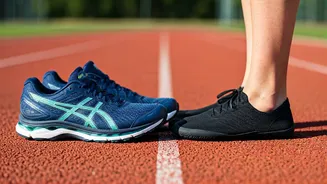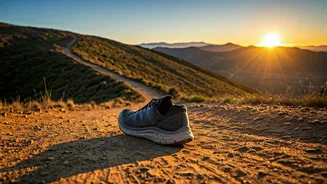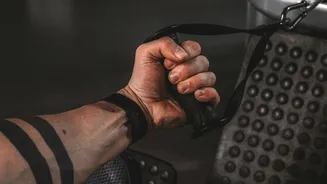Shoes: The Classic Choice
For many, running shoes represent the conventional and familiar way to hit the track or trail. Running shoes are designed with features that provide cushioning,
stability, and support. The cushioning absorbs impact, reducing stress on joints and muscles during each stride. Stability features help control foot motion, which is particularly beneficial for those who overpronate (when the foot rolls inward excessively). The support offered by shoes can also help prevent injuries by maintaining proper alignment of the foot and ankle. There is a wide variety of running shoes available, each designed for different running styles, foot types, and terrains. This diversity allows runners to find a shoe that matches their specific needs, enhancing comfort and performance. From lightweight racing flats to heavily cushioned trail shoes, the options are many.
Barefoot: Natural Running Approach
Barefoot running promotes a more natural gait, allowing the foot to move and adapt freely. This style emphasizes a forefoot or midfoot strike, which can lead to a more efficient and less impactful stride. The lack of cushioning forces the runner to rely on the natural shock absorption capabilities of their feet and legs. Advocates of barefoot running often argue that it strengthens the muscles in the feet and ankles, leading to improved balance and proprioception (awareness of the body's position in space). However, transitioning to barefoot running requires patience and a gradual approach to avoid injury. It's a method that calls for a different technique, emphasizing a shorter stride and increased awareness of the running surface to ensure that one's feet adapt. This requires an initial adjustment period and involves developing the necessary strength and flexibility in the feet.
Foot Mechanics: Key Differences
The way the foot interacts with the ground differs significantly between shoe running and barefoot running. Running shoes offer cushioning, which can reduce the impact on the feet and joints. However, this cushioning can also mask the sensory feedback needed to improve running form and efficiency. In contrast, barefoot running encourages a forefoot or midfoot strike, which allows the foot to absorb impact more naturally and may reduce the stress on the knees. This method also allows the foot's natural arch to function, which contributes to shock absorption. The strength and flexibility of the foot and ankle muscles often improve with barefoot running. However, the lack of support in barefoot running can also leave the feet more susceptible to injuries, especially when encountering unfamiliar surfaces or distances.
Injury: Risks and Prevention
Both shoe running and barefoot running have associated injury risks. Running shoes can sometimes lead to issues such as plantar fasciitis and stress fractures if the wrong type of shoe is selected or if the runner overtrains. Improper shoe fit and the lack of shock absorption can contribute to these injuries. Barefoot running, on the other hand, puts more stress on the feet, ankles, and calves. Injuries, like blisters, stress fractures, and Achilles tendinitis are more common in barefoot runners, especially during the initial transition phase or if proper precautions are not followed. Preventing injuries in either approach involves proper training, gradual progression, and listening to the body. Runners should pay attention to their foot type and running style when choosing shoes. Barefoot runners need to start slowly, gradually increasing distance and duration to allow their feet to adapt. Proper stretching and strengthening exercises are key for both types of runners.
Choosing: Making the Right Call
The 'better' choice between running shoes and barefoot running depends on individual preferences, running goals, and physical condition. Running shoes may be the better option for those who require additional support or cushioning, such as runners with high arches or those running on hard surfaces. They provide protection and comfort, allowing for longer runs with less immediate risk of injury. Barefoot running may appeal to those seeking a more natural running experience, the development of foot strength, and potentially improved running form. However, it's essential to transition slowly and build up mileage gradually. Combining both approaches might also be an option for many runners: using shoes for specific runs and barefoot running for others. The most important thing is to consider your individual needs and to prioritize your comfort and safety when running.










